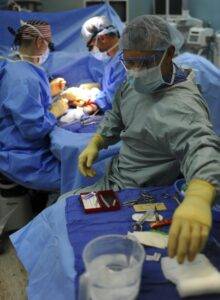Training in obstetrics is vital in preparing healthcare professionals to deliver babies safely, especially in scenarios where complications arise. One of the most crucial skills in this field is forceps, a specialized tool used to assist in childbirth.
Training with newborn baby forceps/OB manikins is essential to ensure practitioners perform forceps delivery effectively. This guide will cover forceps delivery training using OB manikins, from the basics to advanced techniques.
The Role of Forceps in Modern Obstetrics
While forceps deliveries have become less common today due to the rise in cesarean sections, these remain an important tool in obstetrics. Forceps are primarily used in the following childbirth scenarios:
- When the baby needs help navigating through the birth canal due to complications such as fetal distress.
- When the mother is too exhausted to push through with labor, that is, to continue “pushing.”
- When the baby is in a difficult position, such as facing the wrong direction and needing assistance rotating.
Why Forceps Training is Necessary
Despite advances in medical technology, the ability to perform a safe forceps delivery is a skill that every obstetrician should possess. The use of forceps can spell the difference between a successful vaginal delivery and an invasive cesarean section. Proper training ensures that healthcare providers are prepared for situations where forceps are the best option for the safety of the mother and the baby.
Getting Acquainted with Forceps: Tools of the Trade
Before diving into training, we explore the different types of forceps and their specific uses. Forceps come in various shapes and sizes, each designed for different scenarios during childbirth.
Types of Forceps and Their Applications
Understanding when and how to use each type is crucial for effective training. The choice of forceps and technique used can significantly impact the delivery outcome.
- Outlet Forceps: These are designed for use when the baby’s head is already visible at the vaginal opening. These are typically easier to use because the baby is closer to being delivered. These forceps require less force and assist in the final stages.
- Mid-Forceps: These are used when the baby’s head is higher in the birth canal, usually at the level of the ischial spines. Using this tool requires more skill and precision because the baby is not yet visible, and there is less room for error.
- Rotational Forceps: These types are used in more complex situations when the baby’s head is not in the optimal position for delivery. It enables the healthcare provider to rotate the baby’s head, facilitating a safer delivery.
Exploring OB Manikins: What You Need to Know
OB manikins are sophisticated training tools that simulate various childbirth scenarios. OB manikins range from basic models, which simulate straightforward deliveries, to advanced versions that simulate complex emergencies.
The Importance of OB Manikins in Training
OB manikins are lifelike models to help practitioners simulate various childbirth scenarios, providing a safe environment to practice and refine their skills. With manikins, healthcare providers experience a range of situations, from normal deliveries to complex emergencies, without the risk of harm to actual patients.
Different Types of OB Manikins
- Basic Delivery Manikins: This type is ideal for beginners. It provides a simple simulation of normal vaginal birth, allowing trainees to practice the fundamental techniques of delivery, including the use of forceps.
- Advanced Obstetric Manikins: This type offers more complex simulations, including shoulder dystocia, breech presentations, and postpartum hemorrhage. These are equipped with sensors and feedback mechanisms that provide real-time data on the trainee’s performance, such as the force applied during the delivery.
- Full-Body Manikins: These models include the mother and the baby, offering a comprehensive training experience. Full-body manikins are particularly useful for practicing entire birthing scenarios, from the onset of labor to neonatal care.
Setting Up for Success: Preparing Your Training Environment
Creating a conducive training environment is crucial for effective learning. Here are the key elements you need to consider:
- Dedicated Training Area: Set up a quiet, controlled space that mimics a real delivery room. This area should have all necessary tools, including the OB manikin, forceps, a birthing bed, and other medical equipment like a fetal monitor.
- Instructor Supervision: Having an experienced instructor present is invaluable. The instructor can guide, correct mistakes, and offer insights that improve the learning experience.
- Team Training: Obstetric care is a team effort, especially in emergencies. Involve other healthcare professionals, such as nurses and anesthetists, in the training session to simulate the real-life dynamics of a delivery room, enhancing the overall training experience.
Newborn Baby Forceps/OB Manikins: Step-by-Step Delivery Training
With your tools and environment ready, it’s time to begin the training process. Follow this step-by-step guide to master forceps delivery.
Step 1: Gaining Familiarity with the Forceps
The first step in training is to become comfortable with the forceps. Spend time handling the instrument, practicing opening and closing the blades, and familiarizing yourself with the correct grip. Understanding the forceps’ anatomy and mechanics is essential for accurate placement during delivery.
Step 2: Positioning the OB Manikin
Proper positioning of the OB manikin is critical to simulating a realistic delivery. Depending on the scenario you are practicing, adjust the manikin’s position to reflect the appropriate stage of labor. For example, if practicing an outlet delivery, ensure the baby’s head is positioned at the vaginal opening. For more complex scenarios, position the manikin accordingly to simulate the baby’s location higher in the birth canal.
Step 3: Inserting and Positioning the Forceps
- Insertion: Carefully insert the first blade of the forceps into the birth canal, following the contour of the baby’s head. Maintain a gentle touch to avoid exerting too much pressure.
- Positioning: Once the first blade is positioned, insert the second blade. Ensure both blades are properly aligned around the baby’s head, forming a secure grip.
- Locking: After the blades are in place, gently lock the forceps to hold the baby’s head. Check that the blades aren’t causing undue pressure on the baby’s head or neck.
Step 4: Executing the Delivery
- Traction: With the forceps locked in place, apply gentle, steady traction to guide the baby’s head through the birth canal. This step should be done slowly and carefully to avoid injury to the baby or mother.
- Rotation: If the baby is in an abnormal position, rotate the forceps to align the baby’s head. This requires precision and a thorough understanding of the baby’s orientation within the birth canal.
- Completing the Delivery: As the baby’s head emerges, carefully remove the forceps and continue the process. The delivery should progress naturally, with the baby’s shoulders and body following the head.
Step 5: Post-Delivery Procedures
Post-delivery care is a crucial part of the training process. After the baby is delivered, trainees should practice immediate care procedures, such as clearing the baby’s airway, checking vital signs, and ensuring the mother is stable. Some advanced OB manikins are equipped with features that allow for the simulation of neonatal resuscitation, providing a complete training experience.
Advanced Training: Simulating Complications
Once you have mastered basic forceps delivery, it’s time to move on to more advanced scenarios. These simulations prepare healthcare providers for emergencies that arise during childbirth.
- Shoulder Dystocia Simulation: Shoulder dystocia is a serious complication where the baby’s shoulder becomes lodged behind the mother’s pelvic bone, requiring quick and precise intervention to prevent injury to the baby. OB manikins simulate shoulder dystocia, allowing trainees to practice emergency maneuvers like the McRoberts maneuver, which involves hyperflexing the mother’s legs to widen the pelvis, or the Woods’ screw maneuver, which rotates the baby’s shoulder to release it from behind the pelvic bone.
- Breech Birth Simulation: Breech births, where the baby is positioned with feet or buttocks first, present a unique set of challenges. Forceps assist in navigating the baby’s head safely and effectively through the birth canal. Training with OB manikins that simulate breech presentations allows healthcare providers to practice these delicate procedures and develop the skills to manage breech deliveries safely.
- Postpartum Hemorrhage (PPH) Management: Postpartum hemorrhage is one of the leading causes of maternal mortality worldwide. It is characterized by excessive bleeding after childbirth, which quickly becomes life-threatening if not managed promptly. Advanced OB manikins simulate postpartum hemorrhage, enabling trainees to practice critical interventions, such as administering uterotonic medications, performing uterine massage, or, in severe cases, surgical procedures to control the bleeding.
Enhancing Your Training Experience: Tips and Strategies
 Emphasize Repetition and Consistency: Repetition is key to mastering any skill, and forceps delivery is no exception. Regular practice helps build muscle memory, essential for performing the procedure under pressure. Consistent training sessions ensure that skills are retained and refined over time.
Emphasize Repetition and Consistency: Repetition is key to mastering any skill, and forceps delivery is no exception. Regular practice helps build muscle memory, essential for performing the procedure under pressure. Consistent training sessions ensure that skills are retained and refined over time.- Incorporate Reflection and Feedback: After each training session, reflect on your performance. What aspects went well? Where could improvements be made? Review your technique, either through personal reflection or with the help of an instructor, for ongoing development. Video recordings of the sessions provide valuable insights and allow you to observe and analyze your actions.
- Leverage Team-Based Training: Obstetric care is team-based, involving collaboration between obstetricians, nurses, anesthetists, and other healthcare providers. Simulating a real delivery room environment by incorporating team-based training improves communication, coordination, and overall performance during actual deliveries. This approach builds trust and understanding among team members, a vital ingredient in high-pressure situations.
- Manage Stress in High-Pressure Situations: The delivery room could be an intense environment, especially when complications arise. Develop strategies to manage stress to maintain focus and perform effectively under pressure. Incorporate stress management techniques, such as deep breathing exercises, mindfulness, or visualization, into your training to help you stay calm and composed during real-life deliveries.
- Stay Current with Best Practices: The field of obstetrics is constantly evolving, with new research and best practices emerging regularly. Stay updated on these developments to provide the best possible care. Attend workshops, read the latest medical literature, and participate in continuing education programs to ensure your knowledge and skills remain current.
Addressing Common Challenges in Forceps Delivery
Despite thorough training on newborn baby forceps/OB manikins, challenges still arise during forceps-assisted deliveries. Here are some common issues and tips for overcoming these challenges:
- Difficulty in Achieving Proper Forceps Placement: One of the most significant challenges in forceps delivery is ensuring the correct placement of the forceps around the baby’s head. Incorrect placement leads to complications, such as injury to the baby or the mother.
Solution: Practice meticulous attention to detail during training. Secure a clear view of the baby’s head and the birth canal before attempting to place the forceps. Practice with manikins helps develop the precision for proper forceps placement.
- Handling Unexpected Complications: Even with the best preparation, unexpected complications occur during delivery, such as a sudden drop in the baby’s heart rate or the baby becoming stuck in the birth canal.
Solution: Regularly include emergency scenarios in your training to prepare for the unexpected. Practicing these scenarios improves your ability to respond quickly and effectively in real-life emergencies.
- Coping with the Pressure of the Delivery Room: The pressure in the delivery room is overwhelming, particularly when complications arise. Maintaining composure and making sound decisions under stress is crucial.
Solution: Engage in regular stress management exercises and simulate high-pressure scenarios during your training. Deep breathing, mindfulness, and mental rehearsal help stay calm and focused during deliveries. Team-based training replicates the high-pressure environment of a real delivery room, helping build resilience.
Regularly Engage in Newborn Baby Forceps/OB Manikins Training
Training with newborn baby forceps/OB manikins is dynamic and evolving. Like any skill, regular practice and learning are necessary to maintain proficiency and stay current with evolving best practices. By regularly engaging in newborn baby forceps/OB manikin training, healthcare providers ensure they’re prepared for any situation during childbirth, providing the best possible care for mothers and their newborns.
For additional resources and information on related topics, explore these articles on Omegapediatrics.com.
- 12 Reasons to Visit Your Pediatrician Once You Have a New Baby
- Exploring the 9 Common Birth Defects in Children
These articles offer valuable insights into newborn care and pediatric health, further enhancing your understanding of comprehensive healthcare for mothers and babies.


 Emphasize Repetition and Consistency:
Emphasize Repetition and Consistency: 

